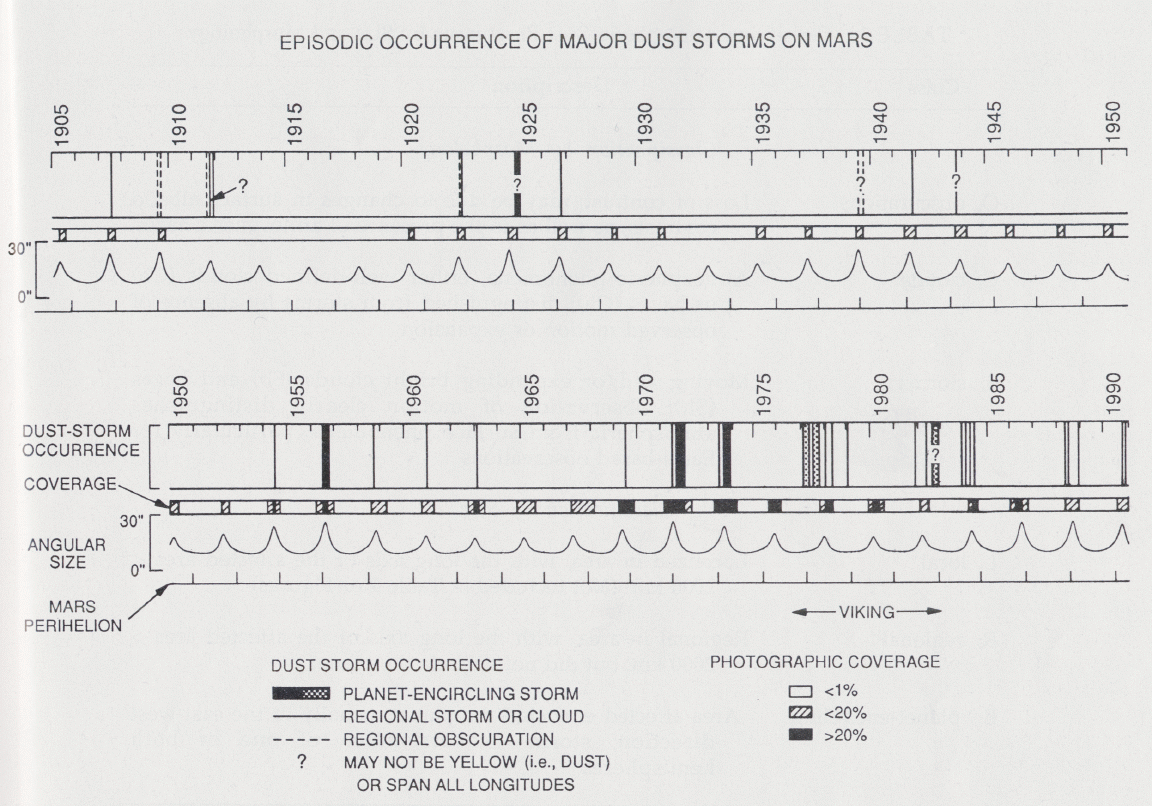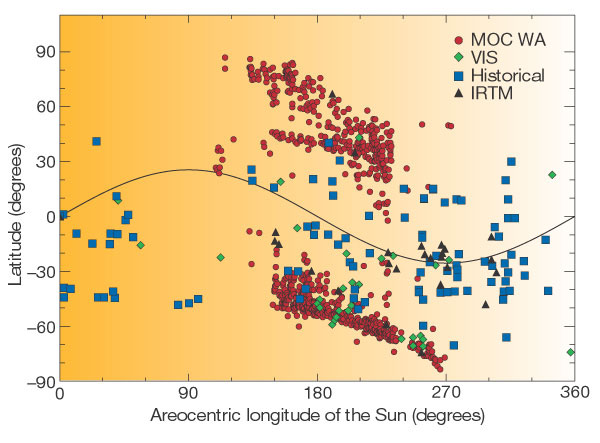Storm Onset
Numerous
theories
exist which attempt to explain how great dust storms
originate on Mars. All involve some form of positive feedback between
the dust and winds, wherein strong winds first raise dust into the
atmosphere, radiative heating of the suspended dust amplifies the
diabatic
drive of the winds, and the wind speed increases, thereby raising
more dust (Zurek et al, 1992). Models based on such theories are best
judged in comparison to the observations which they attempt to explain.
Our understanding of Martian dust storms continues to improve, primarily due to advances in the resolution and frequency of observation of the planet's atmosphere and surface.
When considering telescopic data, it is important to make
note of an observational bias which is still a major factor in limiting
Earth-based observations. This is demonstrated by the timeline at left
taken from Zurek and Martin (1993), in which the Earth-based telescopic
coverage is seen to vary proportionately and periodically with the
apparent size of Mars as seen from Earth. Note also that the observed
planet-encircling dust storms all have occurred within 90° of
Ls of
perihelion
(where Ls is
areocentric
longitude, running from 0° to 360°, with
0° defined as northern hemisphere spring equinox), and none
were observed prior to 1956. Before
Mariner 9
and subsequent orbiting spacecraft, it was not known to what extent
the apparent seasonal nature of storm activity was a product of observational
bias.
Mariner, Viking , and Mars Global Surveyor (MGS) orbiter images demonstrate that local dust storms occur in all seasons and in both northern and southern hemispheres (Kahn et al, 1992; Cantor et al, 1999). However, such storms are more frequent during southern spring and summer, and one can now say with greater confidence that the greatest dust storm activity does in fact correlate with perihelion, which presently occurs around L s = 250°, during the southern hemisphere summer. Mariner and Viking observations indicated that the storms tend to occur in broad latitudinal zones equatorward of the seasonal polar cap edges, more often in the southern subtropics. Longitudinally, storm activity was more common is distinct regions such as Hellas, Noachis-Hellespontus, Argyre, and Solis, Sinai, and Syria Plani in the southern hemisphere, and Chryse-Acidalia, Isidis-Syrtis Major, and Cerberus in the north (Kahn et al, 1992).
With regard to temporal frequency, many Mars years have no
planet-encircling dust storms and some years may even have no regional
storms.
A recent study of 783 local and regional dust storms observed by MGS in 1999 confirm the increased frequency of storms at perihelion, but also show a distinct boundary at the edge of the receding and encroaching seasonal polar caps (Cantor et al, 2001; see figure at right). Additionally, this study provides further evidence of interannual variability, wherein previously active regions such as Solis and Hesperia showed no activity in 1999 while other areas that had been quiescent such as the Arcadia-Amazonis border region showed great activity that same year. In contrast to prior observations, more (8 out of 12) of the regional storms occurred in the northern hemisphere, and half were observed to form as a result of the merge of 2 or more local storms. During the northern fall (L s = 207° to L s = 223°), several regional storms were observed to move from the northern to the southern hemisphere in Xanthe Terra (between 30°W and 50°W). The authors interpreted this as resulting from the low-level south-flowing branch of the Hadley circulation . Balancing estimates of global and cross-equatorial dust mass loading for years with and without planet-encircling dust storms, they suggest that the southern subtropics require 2-3 Mars years to replenish dust sources before a global storm can form. The implication is a cycle involving net transfer of dust from north to south by regional storms over a 2-3 year period, followed by one or more global storms with a net transfer of dust from south to north.
At the surface, theory, laboratory experiments, and the Viking landers' meteorological data all indicate that gusts of 20-30 m/s at 1.6 m height are necessary to raise dust into the atmosphere (Zurek et al, 1992). While such wind speeds were rarely achieved at the lander sites, one mechanism capable of raising dust with lesser background winds is a dust devil , which results from free convection due to direct solar heating of the surface. Those dust devils observed on Mars tend to be larger (>100 m in diameter, >1 km in height) than on Earth (<30 m in diameter, <700 m in height), implying a deeper planetary boundary layer during Mars afternoons and thereby the capability to raise dust to great height. A competing theory for raising dust involves regional winds superimposed on the general circulation , providing enough shear stress at the surface to mobilize the dust (Kahn et al, 1992). Many of the local storms observed show a linear trend which can be explained by regional winds induced by slope and horizontal temperature variations at the surface (e.g., along polar cap edges, albedo contrasts, and thermal inertia boundaries).
While most of these local storms do not grow to larger scales, those that do generally do so in stages (Zurek et al, 1992). Apart from the 2001 event, all observed great storms first expanded latitudinally to cover most or all of a confined zone before expanding longitudinally. As might be expected, the longest lived storms tend to cover greater area and attain the highest dust opacities.
Additional links:
FAQ on dust storm causes - NASA-Ames Mars Atmospheric Modeling Group
NASA-Goddard GCM
Dust devil and storm images - NASA Mars Exploration Gallery
Dust devil tracks - MGS images
Pathfinder dust devil - meteorological data
Our understanding of Martian dust storms continues to improve, primarily due to advances in the resolution and frequency of observation of the planet's atmosphere and surface.
|
Timeline of Major Dust Storms (click to enlarge)
|
Mariner, Viking , and Mars Global Surveyor (MGS) orbiter images demonstrate that local dust storms occur in all seasons and in both northern and southern hemispheres (Kahn et al, 1992; Cantor et al, 1999). However, such storms are more frequent during southern spring and summer, and one can now say with greater confidence that the greatest dust storm activity does in fact correlate with perihelion, which presently occurs around L s = 250°, during the southern hemisphere summer. Mariner and Viking observations indicated that the storms tend to occur in broad latitudinal zones equatorward of the seasonal polar cap edges, more often in the southern subtropics. Longitudinally, storm activity was more common is distinct regions such as Hellas, Noachis-Hellespontus, Argyre, and Solis, Sinai, and Syria Plani in the southern hemisphere, and Chryse-Acidalia, Isidis-Syrtis Major, and Cerberus in the north (Kahn et al, 1992).
|
Latitude vs. Ls of Dust Storms (click
to enlarge)
|
A recent study of 783 local and regional dust storms observed by MGS in 1999 confirm the increased frequency of storms at perihelion, but also show a distinct boundary at the edge of the receding and encroaching seasonal polar caps (Cantor et al, 2001; see figure at right). Additionally, this study provides further evidence of interannual variability, wherein previously active regions such as Solis and Hesperia showed no activity in 1999 while other areas that had been quiescent such as the Arcadia-Amazonis border region showed great activity that same year. In contrast to prior observations, more (8 out of 12) of the regional storms occurred in the northern hemisphere, and half were observed to form as a result of the merge of 2 or more local storms. During the northern fall (L s = 207° to L s = 223°), several regional storms were observed to move from the northern to the southern hemisphere in Xanthe Terra (between 30°W and 50°W). The authors interpreted this as resulting from the low-level south-flowing branch of the Hadley circulation . Balancing estimates of global and cross-equatorial dust mass loading for years with and without planet-encircling dust storms, they suggest that the southern subtropics require 2-3 Mars years to replenish dust sources before a global storm can form. The implication is a cycle involving net transfer of dust from north to south by regional storms over a 2-3 year period, followed by one or more global storms with a net transfer of dust from south to north.
At the surface, theory, laboratory experiments, and the Viking landers' meteorological data all indicate that gusts of 20-30 m/s at 1.6 m height are necessary to raise dust into the atmosphere (Zurek et al, 1992). While such wind speeds were rarely achieved at the lander sites, one mechanism capable of raising dust with lesser background winds is a dust devil , which results from free convection due to direct solar heating of the surface. Those dust devils observed on Mars tend to be larger (>100 m in diameter, >1 km in height) than on Earth (<30 m in diameter, <700 m in height), implying a deeper planetary boundary layer during Mars afternoons and thereby the capability to raise dust to great height. A competing theory for raising dust involves regional winds superimposed on the general circulation , providing enough shear stress at the surface to mobilize the dust (Kahn et al, 1992). Many of the local storms observed show a linear trend which can be explained by regional winds induced by slope and horizontal temperature variations at the surface (e.g., along polar cap edges, albedo contrasts, and thermal inertia boundaries).
While most of these local storms do not grow to larger scales, those that do generally do so in stages (Zurek et al, 1992). Apart from the 2001 event, all observed great storms first expanded latitudinally to cover most or all of a confined zone before expanding longitudinally. As might be expected, the longest lived storms tend to cover greater area and attain the highest dust opacities.
Additional links:
FAQ on dust storm causes - NASA-Ames Mars Atmospheric Modeling Group
NASA-Goddard GCM
Dust devil and storm images - NASA Mars Exploration Gallery
Dust devil tracks - MGS images
Pathfinder dust devil - meteorological data
|
Onset |
The Life Cycle of Martian Dust Storms
Planetary Atmospheres Final Project
by Than Putzig

